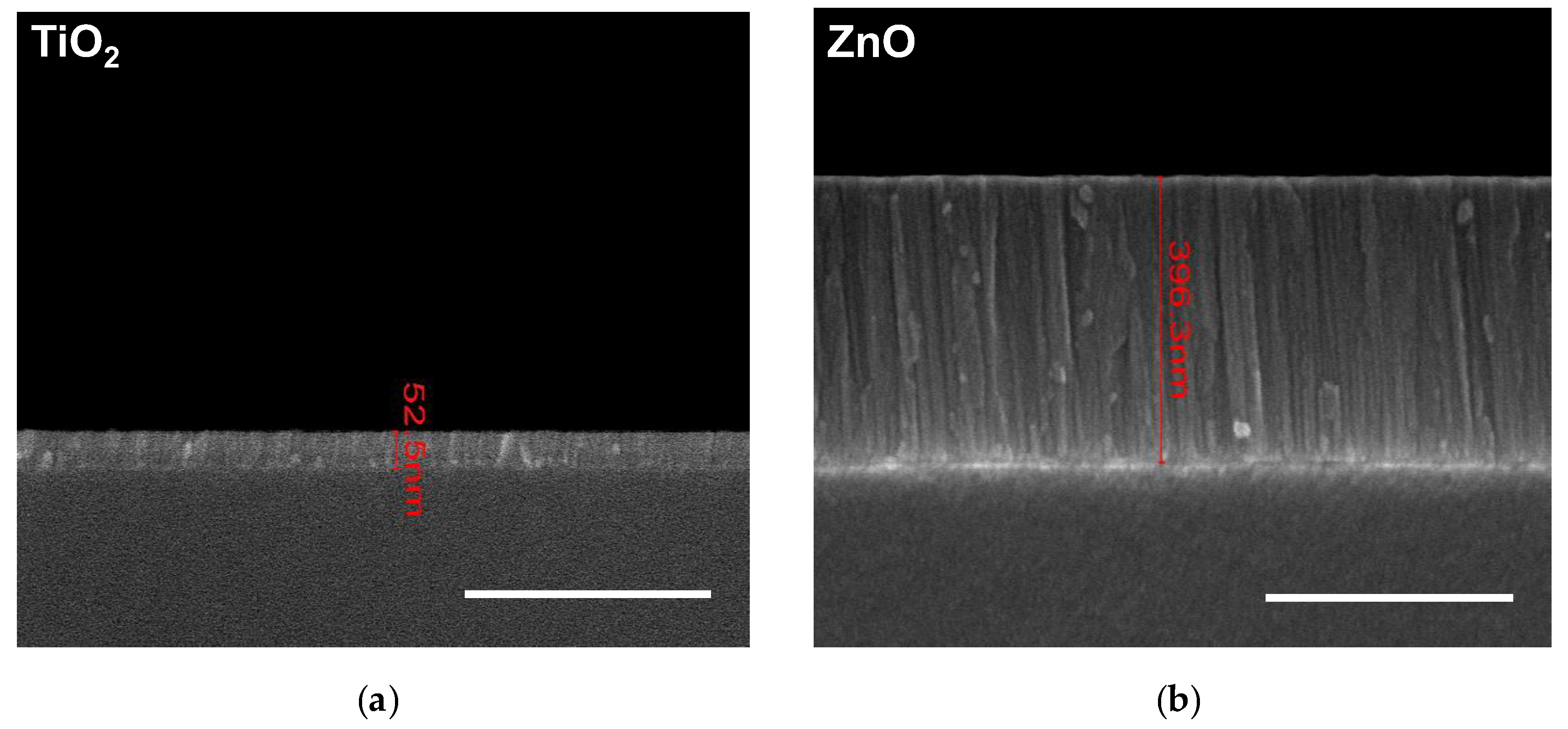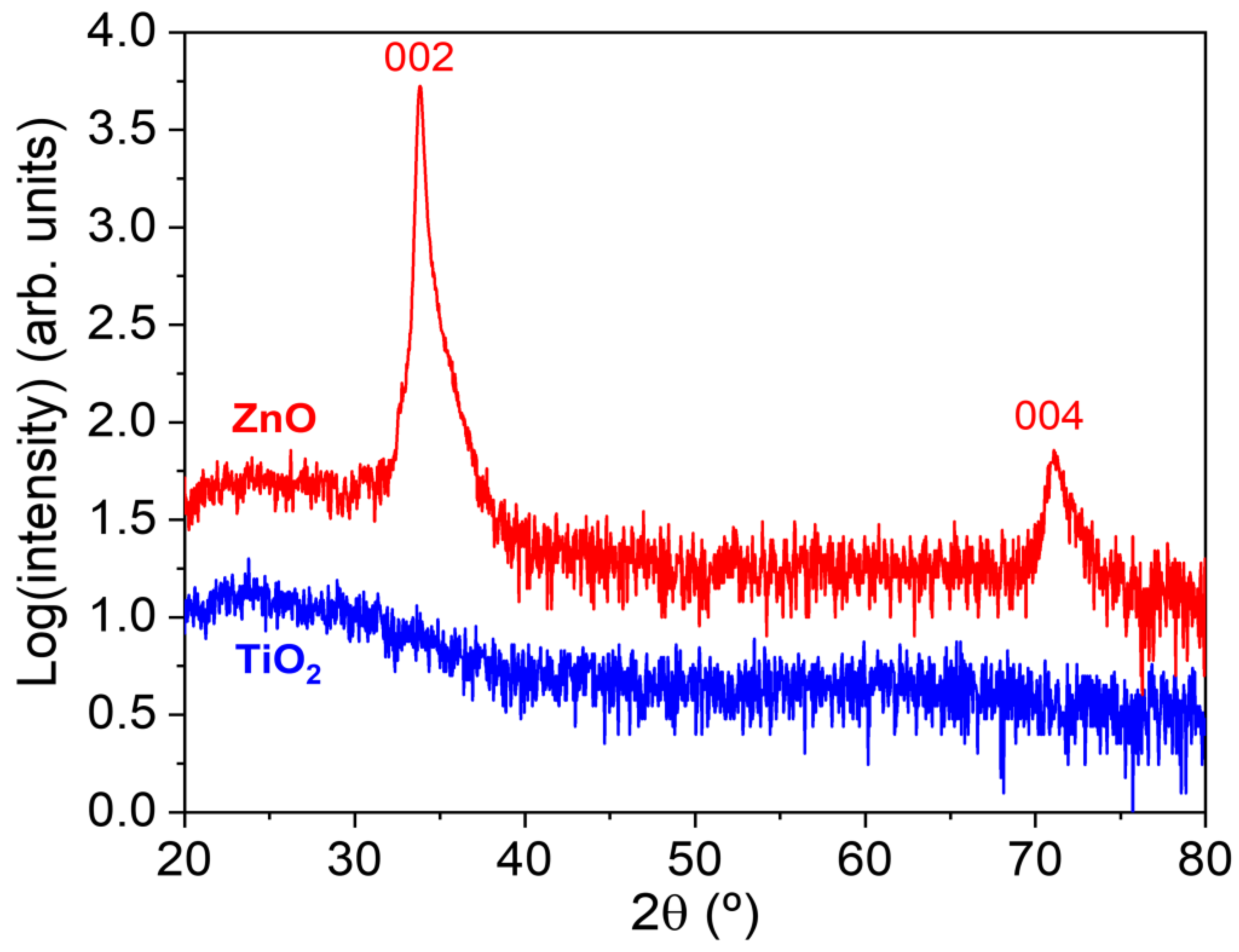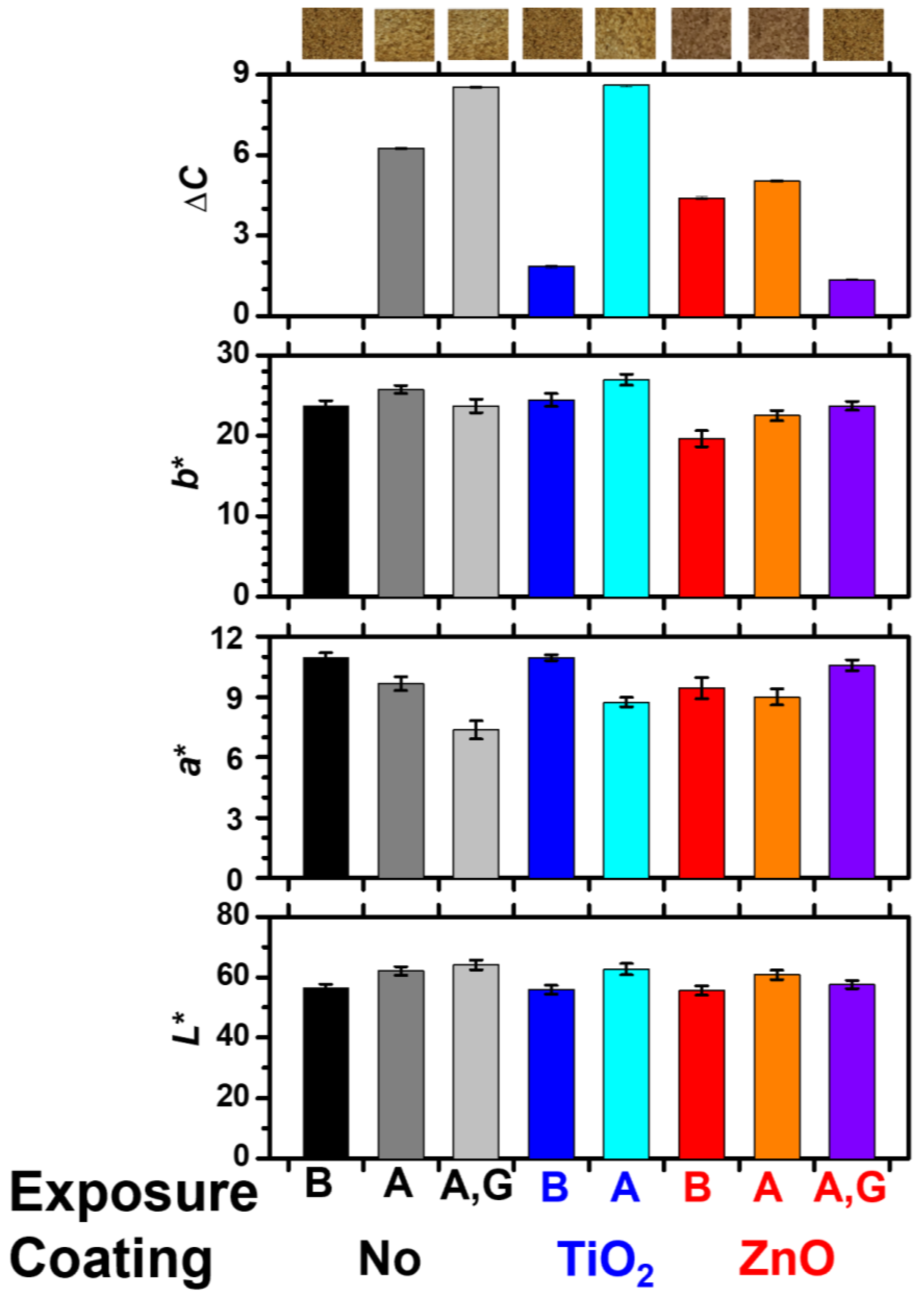Safeguarding Cork’s Beauty and Longevity: Innovations in Deposition of Protective Thin Films
Abstract
:1. Introduction
2. Materials and Methods
3. Results and Discussion
4. Conclusions
Author Contributions
Funding
Institutional Review Board Statement
Informed Consent Statement
Data Availability Statement
Acknowledgments
Conflicts of Interest
References
- Pereira, H. The Rationale behind Cork Properties: A Review of Structure and Chemistry. BioResources 2015, 10, 6207–6229. [Google Scholar] [CrossRef]
- Silva, S.S.P.; Sabino, M.A.; Fernandes, E.M.; Correlo, V.M.; Boesel, L.F.; Reis, R.L. Cork: Properties, capabilities and applications. Int. Mater. Rev. 2005, 50, 345–365. [Google Scholar] [CrossRef]
- Lequin, S.; Chassagne, D.; Karbowiak, T.; Simon, J.-M.; Paulin, C.; Bellat, J.-P. Diffusion of oxygen in cork. J. Agric. Food Chem. 2012, 60, 3348–3356. [Google Scholar] [CrossRef] [PubMed]
- Pereira, H. Cork: Biology, Production and Uses; Elsevier Science: Amsterdam, The Netherlands, 2007. [Google Scholar]
- Gil, L. New cork-based materials and applications. Materials 2015, 8, 625–637. [Google Scholar] [CrossRef] [PubMed]
- Malhotra, A.; Abrol, M.; Shaji, J. Adapting Sustainable Materials for Interiors-Pre & Post Covid Scenarios and Applications. Int. J. Eng. Res. 2022, 12, 1–14. [Google Scholar]
- Fortes, M.A.; Nogueira, M.T. The poison effect in cork. Mater. Sci. Eng. A 1989, 122, 227–232. [Google Scholar] [CrossRef]
- Mateus, M.M.; Bordado, J.M.; dos Santos, R.G. Ultimate use of Cork–Unorthodox and innovative applications. Ciênc. Tecnol. Mater. 2017, 29, 65–72. [Google Scholar] [CrossRef]
- Demertzi, M.; Garrido, A.; Dias, A.C.; Arroja, L. Environmental performance of a cork floating floor. Mater. Des. 2015, 82, 317–325. [Google Scholar] [CrossRef]
- Sakraker, I.; Chazot, O.; Carvalho, J.P. Performance of cork-based thermal protection material P50 exposed to air plasma: An experimental study. CEAS Space J. 2022, 14, 377–393. [Google Scholar] [CrossRef]
- Gibson, L.J.; Ashby, M.F. Cellular Solids; Cambridge University Press: Cambridge, UK, 1997. [Google Scholar]
- Gil, L. Cork Composites: A Review. Materials 2009, 2, 776–789. [Google Scholar] [CrossRef]
- Guo, A.R.; Li, J.; Xiao, D.H.; Liu, C. Preparation and Properties of Insulation Flexible Cork Composites. Cailiao Gongcheng-J. Mater. Eng. 2017, 45, 1–9. [Google Scholar] [CrossRef]
- Kocáb, J.; Kottner, R.; Kossa, A. Characterization of a cork-rubber composite using advanced material models. Mater. Today-Proc. 2019, 12, 340–345. [Google Scholar] [CrossRef]
- Lopes, H.; Silva, S.P.; Carvalho, J.P.; Machado, J. The Influence of Cork and Manufacturing Parameters on the Properties of Cork-Rubber Composites for Vibration Isolation Applications. Sustainability 2021, 13, 11240. [Google Scholar] [CrossRef]
- Lopes, H.; Silva, S.P.; Machado, J. FEA Approach for Predicting the Dynamic Behaviour of Cork-Rubber Composites. Int. J. Simul. Model. 2022, 21, 237–248. [Google Scholar] [CrossRef]
- Lopes, H.; Silva, S.P.; Machado, J. Analysis of the Effect of Shape Factor on Cork-Rubber Composites under Small Strain Compression. Appl. Sci. 2020, 10, 7177. [Google Scholar] [CrossRef]
- Yoon, B.; Cho, S.H.; Lee, S.K.; Cho, K.; Tabe, C.A.; Giese, U.; Nam, J.D.; Suhr, J. Natural cork/potato periderm derivatives enabled interface engineering of elastomer composites for tunable energy-absorbing capabilities. Ind. Crops Prod. 2021, 170, 113763. [Google Scholar] [CrossRef]
- Lanca, M.C.; Peuckert, S.; Neagu, E.R.; Gil, L.; Silva, P.C.; Marat-Mendes, J. Electrical Properties Studies of a Cork/TetraPak®/Paraffin Wax Composite. Adv. Mater. Forum IV 2008, 587–588, 613–617. [Google Scholar] [CrossRef]
- Guo, L.; Huang, G.; Zheng, J.; Li, G. Thermal oxidative degradation of styrene-butadiene rubber (SBR) studied by 2D correlation analysis and kinetic analysis. J. Therm. Anal. Calorim. 2014, 115, 647–657. [Google Scholar] [CrossRef]
- Romero-Sánchez, M.D.; Mercedes Pastor-Blas, M.; Martín-Martínez, J.M.; Walzak, M.J. Addition of ozone in the UV radiation treatment of a synthetic styrene-butadiene-styrene (SBS) rubber. Int. J. Adhes. Adhes. 2005, 25, 358–370. [Google Scholar] [CrossRef]
- Yousefi, F.; Mousavi, S.B.; Heris, S.Z.; Naghash-Hamed, S. UV-shielding properties of a cost-effective hybrid PMMA-based thin film coatings using TiO2 and ZnO nanoparticles: A comprehensive evaluation. Sci. Rep. 2023, 13, 7116–7134. [Google Scholar] [CrossRef]
- Melvin Ng, H.K.; Leo, C.P. Translucent and adsorptive PVA thin film containing microfibrillated cellulose intercalated with TiO2 nanoparticles for dye removal. Colloids Surf. A Physicochem. Eng. 2019, 578, 123590–123598. [Google Scholar]
- Zhang, Z.; Zhang, B.; Grishkewich, N.; Berry, R.; Tam, K.C. Cinnamate-functionalized cellulose nanocrystals as UV-shielding nanofillers in sunscreen and transparent polymer films. Adv. Sustain. Syst. 2019, 3, 1800156–1800160. [Google Scholar] [CrossRef]
- Johansson, W.; Peralta, A.; Jonson, B.; Anand, S.; Österlund, L.; Karlsson, S. Transparent TiO2 and ZnO thin films on glass for UV protection of PV modules. Front. Mater. 2019, 6, 259–268. [Google Scholar] [CrossRef]
- Yang, D.; Ramu, A.G.; Choi, D. Synthesis of Transparent ZnO–TiO2 and Its Nanocomposites for Ultraviolet Protection of a Polyethylene Terephthalate (PET) Film. Catalysts 2022, 12, 1590. [Google Scholar] [CrossRef]
- Tang, A.R.; Huang, Y.Q.; Zhang, W.; Yu, Y.; Yang, Y.; Yuan, Z.R.; Wang, X.Z. Effect of the nano-titanium dioxide (nano-TiO2) coating on the photoaging properties of thermally treated bamboo. Wood Mater. Sci. Eng. 2022, 17, 895–904. [Google Scholar] [CrossRef]
- Jnido, G.; Ohms, G.; Viöl, W. One-Step Deposition of Polyester/TiO2 Coatings by Atmospheric Pressure Plasma Jet on Wood Surfaces for UV and Moisture Protection. Coatings 2020, 10, 184. [Google Scholar] [CrossRef]
- Jnido, G.; Ohms, G.; Viöl, W. Deposition of TiO2 Thin Films on Wood Substrate by an Air Atmospheric Pressure Plasma Jet. Coatings 2018, 9, 441. [Google Scholar] [CrossRef]
- Jnido, G.; Ohms, G.; Viöl, W. Deposition of Zinc Oxide Coatings on Wood Surfaces Using the Solution Precursor Plasma Spraying Process. Coatings 2021, 11, 183. [Google Scholar] [CrossRef]
- Wang, Y.N.; Wu, X.T.; Wang, Y.B.; Tian, Y.Q.; Mu, H.B.; Li, J.K. Hydrophobic and UV-resistant properties of environmentally friendly nano-ZnO-coated wood. Holzforschung 2021, 75, 138–147. [Google Scholar] [CrossRef]
- Al-Shomar, S.M.; Alahmad, W.R. Annealing temperature effect on structural, optical and photocatalytic activity of nanocrystalline TiO2 films prepared by sol-gel method used for solar cell application. Dig. J. Nanomater. Biostruct. 2019, 14, 617–625. [Google Scholar]
- Guang-Lei, T.; Hong-Bo, H.E.; Jian-Da, S. Effect of microstructure of TiO2 thin films on optical band gap energy. Chin. Phys. Lett. 2005, 22, 1787–1789. [Google Scholar] [CrossRef]
- Wasan, R.S.; Nada, M.S.; Wesam, A.T.; Mohammed, A. Synthesis sol-gel derived highly transparent ZnO thin films for optoelectronic applications. Adv. Mater. Phys. Chem. 2012, 2012, 17891–17896. [Google Scholar]
- Najim, S.A.; Alyas, M.M.; Sulaiman, A.A. Structural and optical properties of copper-doped ZnO thin films at different weight percentage. Dig. J. Nanomater. Biostructures 2022, 17, 677–683. [Google Scholar] [CrossRef]
- Martínez-Martínez, D.; Tiss, B.; Glanzmann, L.N.; Wolthuizen, D.J.; Cunha, L.; Mansilla, C.; De Hosson, J.T.M. Protective films on complex substrates of thermoplastic and cellular elastomers: Prospective applications to rubber, nylon and cork. Surf. Coat. Technol. 2022, 442, 128405–128415. [Google Scholar] [CrossRef]
- Cooke, K.E.; Bamber, M.; Bassas, J.; Boscarino, D.; Derby, B.; Figueras, A.; Inkson, B.J.; Rigato, V.; Steer, T.; Teer, D.G. Multilayer nitride coatings by closed field unbalanced magnetron sputter ion plating. Surf. Coat. Technol. 2003, 162, 276–287. [Google Scholar] [CrossRef]
- Scherrer, P. Bestimmung der Größe und der inneren Struktur von Kolloidteilchen mittels Röntgenstrahlen. Nach Ges Wiss Gottingen 1918, 2, 8–100. [Google Scholar]
- Patterson, A. The Scherrer Formula for X-ray Particle Size Determination. Phys. Rev. 1939, 56, 978–982. [Google Scholar] [CrossRef]
- Tauc, J. Optical properties and electronic structure of amorphous Ge and Si. Mater. Res. Bull. 1968, 3, 37–46. [Google Scholar] [CrossRef]
- Tiss, B.; Benfraj, M.; Bouguila, N.; Kraini, M.; Alaya, S.; Cristea, D.; Croitoru, C.; Craciun, V.; Craciun, D.; Prepelita, P.; et al. The effect of vacuum and air annealing in the physical characteristics and photocatalytic efficiency of In2S3: Ag thin films produced by spray pyrolysis. Mater. Chem. Phys. 2021, 270, 124838–124849. [Google Scholar] [CrossRef]
- Handara, V.A.; Illya, G.; Tippabhotla, S.K.; Shivakumar, R.; Budiman, A.S. Center for Solar Photovoltaics (CPV) at Surya University: Novel and Innovative Solar Photovoltaics System Designs for Tropical and Near-Ocean Regions (An Overview and Research Directions). Procedia Eng. 2016, 139, 22–31. [Google Scholar] [CrossRef]
- Wyszecki, G.; Stiles, W.S. Color Science—Concepts and Methods, Quantitative Data and Formulas; Wiley: New York, NY, USA, 1967. [Google Scholar]
- Judd, D.B.; Wyszecki, G. Color in Business, Science and Industry; Wiley: New York, NY, USA, 1975. [Google Scholar]
- Mcdonald, R. Colour Physics for Industry; Society of Dyers and Colourists: Bradford, UK, 1987. [Google Scholar]




| Films | TiO2 | ZnO |
|---|---|---|
| Holder rotation (rpm) | 12 | 0 (static) |
| Distance target-substrate (cm) | 20 | 7 |
| Base pressure (×10−6 mbar) | 15 | 2.5 |
| Target surface dimension | 38 cm × 17.5 cm | 20 cm × 10 cm |
| Ar flow (sccm) | 20 | 25 |
| O2 flow (sccm) | 15 | 17 |
| Working pressure (10−3 mbar) | 1.7 | 5 |
| Current (A) | 6.27 | 1 |
| Voltage (V) | 430 ± 5 | 336 ± 3 |
| Deposition time (min) | 60 | 10 |
Disclaimer/Publisher’s Note: The statements, opinions and data contained in all publications are solely those of the individual author(s) and contributor(s) and not of MDPI and/or the editor(s). MDPI and/or the editor(s) disclaim responsibility for any injury to people or property resulting from any ideas, methods, instructions or products referred to in the content. |
© 2023 by the authors. Licensee MDPI, Basel, Switzerland. This article is an open access article distributed under the terms and conditions of the Creative Commons Attribution (CC BY) license (https://creativecommons.org/licenses/by/4.0/).
Share and Cite
Tiss, B.; Martínez-Martínez, D.; Mansilla, C.; Borges, J.; Andritschky, M.; Cunha, L. Safeguarding Cork’s Beauty and Longevity: Innovations in Deposition of Protective Thin Films. Sustainability 2023, 15, 16701. https://doi.org/10.3390/su152416701
Tiss B, Martínez-Martínez D, Mansilla C, Borges J, Andritschky M, Cunha L. Safeguarding Cork’s Beauty and Longevity: Innovations in Deposition of Protective Thin Films. Sustainability. 2023; 15(24):16701. https://doi.org/10.3390/su152416701
Chicago/Turabian StyleTiss, Belgacem, Diego Martínez-Martínez, Catalina Mansilla, Joel Borges, Martin Andritschky, and Luís Cunha. 2023. "Safeguarding Cork’s Beauty and Longevity: Innovations in Deposition of Protective Thin Films" Sustainability 15, no. 24: 16701. https://doi.org/10.3390/su152416701







